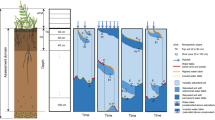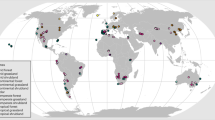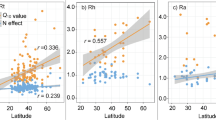Abstract
Soil pH regulates the capacity of soils to store and supply nutrients, and thus contributes substantially to controlling productivity in terrestrial ecosystems1. However, soil pH is not an independent regulator of soil fertility—rather, it is ultimately controlled by environmental forcing. In particular, small changes in water balance cause a steep transition from alkaline to acid soils across natural climate gradients2,3. Although the processes governing this threshold in soil pH are well understood, the threshold has not been quantified at the global scale, where the influence of climate may be confounded by the effects of topography and mineralogy. Here we evaluate the global relationship between water balance and soil pH by extracting a spatially random sample (n = 20,000) from an extensive compilation of 60,291 soil pH measurements. We show that there is an abrupt transition from alkaline to acid soil pH that occurs at the point where mean annual precipitation begins to exceed mean annual potential evapotranspiration. We evaluate deviations from this global pattern, showing that they may result from seasonality, climate history, erosion and mineralogy. These results demonstrate that climate creates a nonlinear pattern in soil solution chemistry at the global scale; they also reveal conditions under which soils maintain pH out of equilibrium with modern climate.
This is a preview of subscription content, access via your institution
Access options
Subscribe to this journal
Receive 51 print issues and online access
$199.00 per year
only $3.90 per issue
Buy this article
- Purchase on Springer Link
- Instant access to full article PDF
Prices may be subject to local taxes which are calculated during checkout


Similar content being viewed by others

References
Brady, N. C. & Weil, R. R. in The Nature and Properties of Soils 15th edn, 375–419 (Pearson Education, 2002)
Chadwick, O. A. et al. The impact of climate on the biogeochemical functioning of volcanic soils. Chem. Geol. 202, 195–223 (2003)
Dahlgren, R. A., Boettinger, J. L., Huntington, G. L. & Amundson, R. G. Soil development along an elevational transect in the western Sierra Nevada, California. Geoderma 78, 207–236 (1997)
Jenny, H. in Factors of Soil Formation: A System of Quantitative Pedology 104–196 (Dover, 1994)
Sposito, G. in The Chemistry of Soils 2nd edn, 275–295 (Oxford, 2008)
George, E., Horst, W. & Neumann, E. in Mineral Nutrition of Higher Plants (ed. Marschner, P. ) 409–455 (Elsevier, 2012)
van Breemen, N., Mulder, J. & Driscoll, C. T. Acidification and alkalization of soils. Plant Soil 75, 283–308 (1983)
Chadwick, O. A. & Chorover, J. The chemistry of pedogenic thresholds. Geoderma 100, 321–353 (2001)
Vitousek, P. M. & Chadwick, O. A. Pedogenic thresholds and soil process domains in basalt-derived soils. Ecosystems 16, 1379–1395 (2013)
Budyko, M. I. in Climate and Life 317–370 (Academic Press, 1974)
Hilley, G. E., Chamberlain, C. P., Moon, S., Porder, S. & Willet, S. D. Competition between erosion and reaction kinetics in controlling silicate-weathering rates. Earth Planet. Sci. Lett. 293, 191–199 (2010)
Porder, S. et al. Linking geomorphology, weathering and cation availability in the Luquillo Mountains of Puerto Rico. Geoderma 249/250, 100–110 (2015)
Batjes, N. H. Harmonised soil property values for broad-scale modelling (WISE30sec) with estimates of global soil carbon stocks. Geoderma 269, 61–68 (2016)
Shangguan, W., Dai, Y., Duan, Q., Liu, B. & Yuan, H. A global soil data set for Earth System Modeling. J. Adv. Model. Earth Syst . 6, 249–263 (2014)
FAO-UNESCO. FAO Soil Map of the World http://www.fao.org/soils-portal/soil-survey/soil-maps-and-databases/faounesco-soil-map-of-the-world/en/ (The Food and Agriculture Organization of the United Nations, 1998)
Schneider, U. et al. GPCC Full Data Reanalysis Version 7.0 at 1.0°: Monthly Land-Surface Precipitation from Rain-Gauges built on GTS-based and Historic Datahttp://doi.org/10.5676/DWD_GPCC/FD_M_V7_050 (2015)
Leuning, R., Zhang, Y. Q., Rajaud, A., Cleugh, H. & Tu, K. A simple surface conductance model to estimate regional evaporation using MODIS leaf area index and the Penman–Monteith equation. Wat. Resour. Res . 44, 1–17 (2008)
Mueller, B. et al. Benchmark products for land evapotranspiration: LandFlux-EVAL multi-data set synthesis. Hydrol. Earth Syst. Sci. 17, 3707–3720 (2013)
Milly, P. Climate, interseasonal storage of soil water, and the annual water balance. Adv. Water Resour. 17, 19–24 (1994)
Kutzbach, J., Bonan, G., Foley, J. & Harrison, S. P. Vegetation and soil feedbacks on the response of the African monsoon to orbital forcing in the early to middle Holocene. Nature 384, 623–626 (1996)
Fitzsimmons, K. E. et al. Late Quaternary paleoenvironmental change in the Australian drylands. Quat. Sci. Rev. 74, 78–96 (2013)
Auler, A. S. & Smart, P. L. Late Quaternary paleoclimate in semiarid northeastern Brazil from U-series dating of travertine and water-table speleothems. Quat. Res. 55, 159–167 (2001)
Chase, B. M. & Meadows, M. E. Late Quaternary dynamics of southern Africa’s winter rainfall zone. Earth Sci. Rev. 84, 103–138 (2007)
Ford, D. & Williams, P. in Karst Hydrogeology and Geomorphology 1–8 (Wiley, 2007)
Hartmann, J. & Moosdorf, N. The new global lithological map database GLiM: a representation of rock properties at the Earth surface. Geochem. Geophys. Geosyst. 13, Q12004 (2012)
Nanzyo, M., Dahlgren, R. & Shoji, S. in Volcanic Ash Soils: Genesis, Properties and Utilization 145–188 (Elsevier, 1993)
Ulrich, B. Natural and anthropogenic components of soil acidification. Z. Pflanzenernährung Bodenkunde. 149, 702–717 (1986)
Vitousek, P. M. et al. Soils, agriculture, and society in precontact Hawai’i. Science 304, 1665–1669 (2004)
Priestley, C. H. B. & Taylor, R. J. On the assessment of surface heat flux and evaporation using large scale parameters. Mon. Weath. Rev. 100, 81–92 (1972)
Monteith, J. & Unsworth, M. in Principles of Environmental Physics 4th edn, 217–247 (Elsevier, 2013)
Eichinger, W., Parlange, M. B. & Stricker, H. On the concept of equilibrium evaporation and the value of the Priestley-Taylor coefficient. Wat. Resour. Res . 32, 161–164 (1996)
Zhang, Y. Q., Chiew, H. S., Zhang, L., Leuning, R. & Cleugh, H. A. Estimating catchment evaporation and runoff using MODIS leaf area index and the Penman Monteith equation. Wat. Resour. Res . 44, W10420 (2008)
Kelliher, F. M., Leuning, R., Raupach, M. R. & Schulze, E. D. Maximum conductances for evaporation from global vegetation types. Agric. For. Meteorol. 73, 1–16 (1995)
Allen, R. G., Pereira, L. S., Raes, D. & Smith, M. Crop Evapotranspiration—Guidelines for Computing Crop Water Requirements. FAO Irrigation and Drainage Paper 56, http://www.fao.org/docrep/x0490e/x0490e00.htm (FAO, 1998)
Fisher, J. B., Tu, K. P. & Baldocchi, D. D. Global estimates of the land–atmosphere water flux based on monthly AVHRR and ISLSCP-II data, validated at 16 FLUXNET sites. Remote Sens. Environ. 112, 901–919 (2008)
Schneider, U., Becker, A. & Finger, P. GPCC’s new land surface precipitation climatology based on quality-controlled in situ data and its role in quantifying the global water cycle. Theor. Appl. Climatol. 115, 15–40 (2014)
Legates, D. R. & Willmott, C. J. Mean seasonal and spatial variability in gauge-corrected, global precipitation. Int. J. Climatol. 10, 111–127 (1990)
Wielicki, B. A. et al. Clouds and the Earth’s Radiant Energy System (CERES): an Earth observing system experiment. Bull. Am. Meteorol. Soc. 77, 853–868 (1996)
Stackhouse, P. W. et al. The NASA/GEWEX surface radiation budget release 3.0: 24.5-Year Dataset. GEWEX News 21, 10–12 (2011)
Harris, I., Jones, P. D., Osborne, T. J. & Lister, D. H. Updated high-resolution grids of monthly climatic observations—the CRU TS3.10 dataset. Int. J. Climatol. 34, 623–642 (2014)
Amante, C. & Eakins, B. W. ETOPO1 1 Arc-Minute Global Relief Model: Procedures, Data Sources and Analysis. NOAA Technical Memorandum NESDIS NGDC-24, http://www.dx.doi.org/10.7289/V5C8276M (National Geophysical Data Center, NOAA, 2009)
Friedl, M. A. et al. Global land cover mapping from MODIS: algorithms and early results. Remote Sens. Environ. 83, 287–302 (2002)
Liang, S. & Xiao, Z. Global Land Surface Products: Leaf Area Index Product Data Collection (1985-2010) . http://www.dx.doi.org/10.6050/glass863.3004.db (Beijing Normal University, 2012)
Xiao, Z. et al. Use of general regression neural networks for generating the GLASS leaf area index product from time series MODIS surface reflectance. IEEE Trans. Geosci. Remote Sens . 52, 209–223 (2013)
Batjes, N. H. Harmonized soil profile data for applications at global and continental scales: updates to the WISE database. Soil Use Manage . 25, 124–127 (2009)
Leenaars, J. G. B., van Oostrum, A. M. J. & Ruiperez Gonzalez, M. Africa Soil Profiles Database, Version 1.2. A Compilation of Georeferenced and Standardized Legacy Soil Profile Data for Sub-Saharan Africa (with Dataset). ISRIC Report 2014/1 (Africa Soil Information Service (AfSIS) project, ISRIC, World Soil Information, 2012)
Hiederer, R., Jones, R. J. & Daroussin, J. Soil Profile Analytical Database for Europe (SPADE): reconstruction and validation of the measured data (SPADE/M). Geograf. Tids. Dan. J. Geogr. 106, 71–85 (2006)
Cooper, M., Mendes, L. M. S., Silva, W. L. C. & Sparovek, G. A national soil profile database for Brazil available to international scientists. Soil Sci. Soc. Am. J . 69, 649–652 (2005)
Jobbágy, E. G. & Jackson, R. B. The uplift of soil nutrients by plants: biogeochemical consequences across scales. Ecology 85, 2380–2389 (2004)
Libohova, Z. et al. Converting pH 1:1 H2O and 1:2 CaCl2 to 1:5 H2O to contribute to a harmonized global soil database. Geoderma 213, 544–550 (2014)
Willmott, C. J., Matsuura, K. & Robeson, S. M. Ambiguities inherent in sums-of-squares-based error statistics. Atmos. Environ. 43, 749–752 (2009)
Efron, B. Bootstrap methods: another look at the jackknife. Ann. Stat. 7, 1–26 (1979)
Trexler, J. C. & Travis, J. Nontraditional regression analyses. Ecology 74, 1629–1637 (1993)
R Core Team . R: a Language and Environment for Statistical Computing . https://www.R-project.org/ (Foundation for Statistical Computing, 2016)
Soil Survey Staff. In Kellogg Soil Survey Laboratory Methods Manual Version 5.0 Soil Survey Investigations. Report No 42 (eds Burt, R. & Soil Survey Staff) http://www.nrcs.usda.gov/wps/portal/nrcs/detail/soils/home/?cid=nrcs142p2_(United States Department of Agriculture Natural Resources Conservation Service, 2014)
Plummer, N. L. & Busenberg, E. The solubilities of calcite, aragonite and vaterite in CO2 H2O solutions between 0 and 90°C, and an evaluation of the aqueous model for the system CaCO3–CO2–H2O. Geochim. Cosmochim. Acta 46, 1011–1040 (1982)
Soetaert, K. rootSolve: nonlinear root finding, equilibrium and steady-state analysis of ordinary differential equations. R package version 1.6 https://cran.r-project.org/web/packages/rootSolve/index.html (2009)
Parkhurst, D. L. & Appelo, C. A. J. Users Guide to PHREEC (Version 3.0): a Computer Program for Speciation, Batch-Reaction, One-Dimensional Transport, and Inverse Geochemical Calculations . http://www.brr.cr.usgs.gov/projects/GWC_coupled/phreeqc/index.html (United States Geological Survey, 2013)
Sander, R. Compilation of Henry’s law constants (version 4.0) for water as solvent. Atmos. Chem. Phys. 15, 4399–4981 (2015)
Keeling, C. D. & Whorf, T. P. Atmospheric CO2 concentrations derived from flask air samples at sites in the SIO network. In Trends: A Compendium of Data on Global Change http://cdiac.ornl.gov/trends/co2/sio-keel-flask/sio-keel-flaskmlo_c.html# (Carbon Dioxide Information Analysis Center, Oak Ridge National Laboratory, United States Department of Energy, 2004)
Reuss, J. O., Walthall, P. M., Roswall, E. C. & Hopper, R. W. E. Aluminum solubility, calcium-aluminum exchange, and pH in acid forest soils. Soil Sci. Soc. Am. J . 54, 374–380 (1990)
Acknowledgements
We thank P. Vitousek, S. Fendorf, X. Feng and C. Kouba for guidance and comments. Soil data were provided by multiple contributing organizations (Extended Data Table 1). Funding for E.W.S. was provided by a Graduate Research Fellowship from the United States National Science Foundation.
Author information
Authors and Affiliations
Contributions
Research was conceived by E.W.S., O.A.C., Y.L., N.L.B., J.P.S. and J.E.J. Data aggregation and processing tasks were shared by E.W.S., Y.L. and Y.D. Statistical analysis and chemical calculations were performed by E.W.S. The manuscript was written by E.W.S. with input from all authors.
Corresponding author
Ethics declarations
Competing interests
The authors declare no competing financial interests.
Additional information
Reviewer Information Nature thanks R. Merckx, S. Porder and the other anonymous reviewer(s) for their contribution to the peer review of this work.
Extended data figures and tables
Extended Data Figure 1 Soil pH versus calcite and exchangeable aluminium.
Transparent points show a spatial sample of 20,000 measurements from the NCSS database. a, The relationship between soil pH at 0.5 m and CaCO3 equivalents as a mass percentage. The yellow line shows the calculated pH of a solution in equilibrium with calcite and atmospheric CO2 (345 parts per million) at 25 °C. b, The relationship between soil pH at 0.5 m and the log-ratio of exchangeable calcium (CaX) to exchangeable aluminium (AlX), which is thought to control the pH of gibbsite-buffered soils. The yellow line is the fit by least-squares regression (b0 = 4.96, b1 = 0.32, R2 = 0.36, P < 0.01).
Extended Data Figure 2 Results of spatial resampling.
Transparent points show a spatial sample of 20,000 measurements (a and b) and a random sample of 20,000 measurements (c and d). a, c, pH at 0.5 m depth versus MAP minus PET. b, d, The geographic distribution of measurements in the Americas.
Extended Data Figure 3 Soil pH at 0.5 m depth versus alternative water-balance models.
Transparent points show a spatial sample of 20,000 measurements of soil pH at 0.5 m depth. a, Soil pH versus MAP. b, Soil pH versus MAP minus PET estimated using the Priestley–Taylor method driven by CERES radiation data. c, MAP minus AET, from the LandFlux-EVAL synthesis. d, MAP minus PET estimated using the Priestley–Taylor method driven by GEWEX radiation data.
Extended Data Figure 4 Soil pH at 0.1 m depth versus MAP minus PET.
Transparent points show a spatial sample of 20,000 measurements of soil pH at 0.1 m depth. Side panels show histograms of MAP minus PET and soil pH, and yellow lines show predicted pH values of CaCO3-buffered soils (8.2) and Al(OH)3-buffered soils (5.1).
Extended Data Figure 5 Calcite and exchangeable aluminium versus MAP minus PET.
Transparent points represent a spatial sample of 20,000 measurements from the NCSS database. a, Calcite (CaCO3) equivalents as mass percentage versus MAP minus PET. b, Exchangeable aluminium as a percentage of the effective cation exchange capacity versus MAP minus PET. These data are not reported for all samples in the NCSS database, and so points on the plot represent only the subset of the data with reported values.
Extended Data Figure 6 Dry-climate soil pH versus seasonality, relief and carbonates.
Transparent points show soil pH at 0.5 m depth in the driest quartile of MAP minus PET (n = 5,000). a, Soil pH versus the coefficient of variation (CV) of precipitation. b, Soil pH versus local relief. c, Violin plots showing soil pH versus carbonate lithology. Panels d and e show the proportion of the observations with pH < 6.5, binned into deciles of the variable on the x axis; panel f shows the proportion in each lithologic category. Black lines show logistic regression fits, with associated chi-squared (χ2) statistics and P values from likelihood ratio tests for precipitation CV (χ2 = 167.65, P < 0.01), local relief (χ2 = 76.5, P < 0.01) and carbonate lithology (χ2 = 91.42, P < 0.01). Dashed lines show the proportion of observations with pH < 6.5.
Extended Data Figure 7 Wet-climate soil pH versus seasonality, relief and carbonates.
Transparent points show soil pH at 0.5 m depth in the wettest quartile of MAP minus PET (n = 5,000). a, Soil pH versus the coefficient of variation of precipitation. b, Soil pH versus local relief. c, Violin plots showing soil pH versus carbonate lithology. Panels d and e show the proportion of the observations with pH >6.5, binned into deciles of the variable on the x axis; panel f shows the proportion in each lithologic category. Black lines show logistic regression fits, with associated χ2 statistics and P values from likelihood ratio tests for precipitation CV (χ2 = 3.5, P = 0.06), local relief (χ2 = 61.29, P < 0.01) and carbonate lithology (χ2 = 156.41, P < 0.01). Dashed lines show the proportion of observations with pH > 6.5.
PowerPoint slides
Rights and permissions
About this article
Cite this article
Slessarev, E., Lin, Y., Bingham, N. et al. Water balance creates a threshold in soil pH at the global scale. Nature 540, 567–569 (2016). https://doi.org/10.1038/nature20139
Received:
Accepted:
Published:
Issue Date:
DOI: https://doi.org/10.1038/nature20139
This article is cited by
-
Shifts in plant resource use strategies across climate and soil gradients in dryland steppe communities
Plant and Soil (2024)
-
Aluminum mobilization characteristics in four typical soils from different climate zones during their acidification
Plant and Soil (2024)
-
Tree species identity drives the vertical distribution of soil carbon and nutrient concentrations in the Loess Plateau, China
Plant and Soil (2024)
-
Synergistic effects of leaf nitrogen and phosphorus on photosynthetic capacity in subtropical forest
Theoretical and Experimental Plant Physiology (2024)
-
Carbon and nutrient limitations of soil microbial metabolism in Quercus aquifolioides forest ecosystems along a precipitation gradient on the eastern Qinghai-Tibetan Plateau
Plant and Soil (2023)
Comments
By submitting a comment you agree to abide by our Terms and Community Guidelines. If you find something abusive or that does not comply with our terms or guidelines please flag it as inappropriate.


